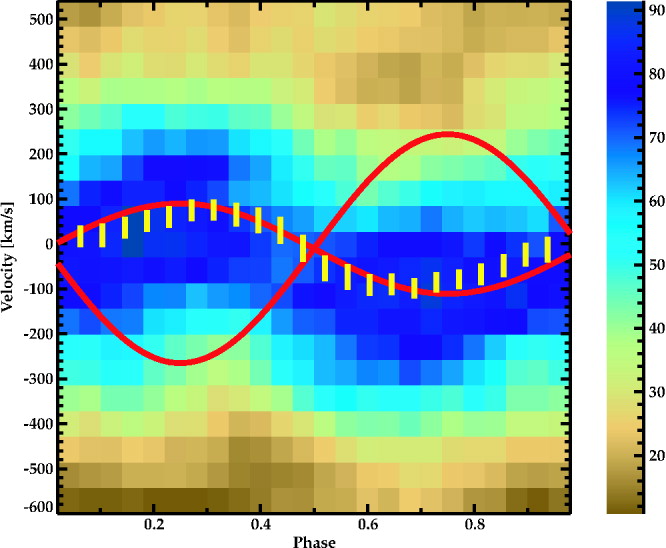
 Credit: David P. Huenemoerder et al., 2006, The Astrophysical Journal, volume 650, pg. 1119
Credit: David P. Huenemoerder et al., 2006, The Astrophysical Journal, volume 650, pg. 1119
Close Hot Dancing
Many stars have companions so close they actually touch. These contact binary systems whirl rapidly around, and rotate with the same period they revolve. This rapid rotation stirs strong interior electric currents generating powerful magnetic fields. Tangling and untangling, such fields heat the outer stellar atmosphere producing million degree hot coronae which produce X-ray emission in the process. But do both stars in a contact binary system produce hot coronae? A study of one such system, called VW Cep, with the High Energy Transmission Grating on the Chandra X-ray Observatory has helped provide the answer. The image above shows velocities of X-ray emission lines in the VW Cep corona as yellow bars. The image background shows the velocity variation while the yellow bars shows the variation of the center of the line. The red curves represent the observed velocities of the more massive and less mass star as they revolve around each other. The X-ray emission in VW Cep clearly follows the motion of the more massive star, showing that the corona from this star dominates the X-ray emission.
<
HEA Dictionary ● Archive
● Search HEAPOW
● Other Languages
● HEAPOW on Facebook
● Download all Images
● Education ● HEAD
>
Each week the HEASARC
brings you new, exciting and beautiful images from X-ray and Gamma ray
astronomy. Check back each week and be sure to check out the HEAPOW archive!
Last modified Tuesday, 27-Feb-2024 10:10:19 EST


